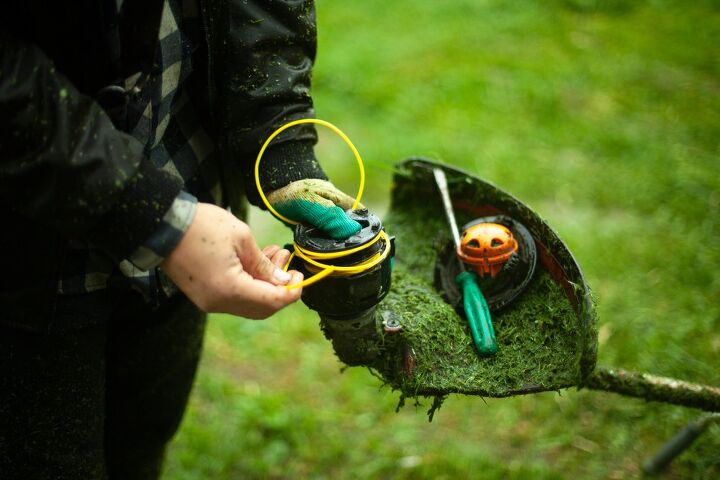Can You Put A Blade On A Walk Behind String Trimmer?

Walk behind string trimmers are exceptional at reaching places that standard lawnmowers can’t go. If you want to up the ante, can you put a blade on a walk behind string trimmer?
You can put a blade on a walk behind string trimmer as long as the diameter fits within the device. Doing so will help you cut through thicker areas of vegetation more easily and leave your grass looking more polished. Avoid installing a new blade right after using the trimmer, or you might burn yourself.
Continue reading to learn if it’s possible to install a blade on a walk behind string trimmer and how to do so. Additionally, learn what not to do when completing this type of project!
Do You Need Lawn and Tree Maintenace Pros?
Get free, zero-commitment quotes from pro contractors near you.

What Is a Walk Behind String Trimmer?
If you’re unfamiliar, what exactly is a walk behind string trimmer?
A walk behind string trimmer is a piece of equipment meant to help you accomplish quick and easy weed or grass whacking. It is compact and highly maneuverable, with better surface area coverage than a hand-held version.
When using one, you will cut your yard in a manner that is most akin to utilizing a lawnmower. However, they are much smaller in size and utilize reinforced composite nylon materials in the form of “strings” that rotate at high speeds to get the job done.
Their main advantage over a lawnmower is that they can get into tight spaces and around obstacles with ease. Because they’re lightweight and easy to operate, they are perfect for smaller yards or spaces where a lawnmower would be too cumbersome to use.
Is It Possible to Put a Blade on a Walk Behind String Trimmer?
Now that you know a little bit more about what a walk behind string trimmer is, the next logical question to ask is: can it be outfitted with a blade?
In short, the answer is yes. However, there are a few things you should keep in mind before taking on this project.
One of the main benefits of using a walk behind string trimmer is that the nylon strings are much less likely to cause damage to surfaces when compared to traditional blades. So, if you’re looking to primarily mulch leaves or chop up small branches, then installing a blade on your walk behind string trimmer may not be the best option for you.
On the other hand, if you’re looking to cut taller grass or thicker weeds, then putting a blade on your trimmer can definitely give you the extra power and precision that you need.
Just be sure to take into account the width of the blade in comparison to the width of your walk behind string trimmer- you don’t want it to be too big or too small.
Why Would I Want to Install a Blade on a Walk Behind String Trimmer?
There are a few reasons why you may want to install a blade on your walk behind string trimmer:
- To be able to trim areas that are higher off the ground than what is possible with the standard tool
- To be able to cut through thicker areas of growth more easily
- For a more finished look (similar to what you would get with a lawnmower)
How to Put a Blade on a Walk Behind String Trimmer
How can we make this happen? Follow the steps below.
To install a blade on a walk behind string trimmer:
- Scope out your string trimmer. There are many different types of walk behind string trimmers out there, so be sure to double-check with your manufacturer to see what type of blade is compatible.
- Purchase a blade that will fit inside of your string trimmer.
- Remove the head of your walk behind string trimmer and take off the cover to expose the engine.
- Locate the screws that hold the string trimmer nylon strings in place and remove them.
- Attach the new blade with screws.
- Reassemble your trimmer and go for a test run to make sure everything works properly.
The new blade should be an exact fit, and if it isn’t, you can use a spacer.
What Not to Do When Putting a Blade on a Walk Behind String Trimmer
While doing this project, there are some things you should avoid.
- Don’t try to change the design of your walk behind string trimmer.
- Do not swap out trimmer strings right after using the device. It must cool down first, or you risk burning yourself.
- Avoid using a blade that is too wide for your walk behind string trimmer- this will only result in damage to both the unit and the blade.
Last but not least, don’t attempt this project if you don’t feel confident in your handyman or handywoman skills.
There are professional services available, but if that’s not an option, then do some more research on the exact tools needed and steps involved before you begin. You don’t want to hurt yourself in the process!
Related Questions
What are the two basic types of string trimmers?
The two main types of string trimmers are electric and gas.Electric string trimmers can be either corded or cordless and are turned on using a switch, rather than by pulling a ripcord. Because they are less aggressive, they’re better suited for a smaller yard.Gas string trimmers are cordless, have two-cycle engines, and require a combination of gas and oil to function. They work particularly well for big grassy areas.
Are walk behind string trimmers worth it?
This depends on who you ask.If ease of use is most important to you, then the answer is yes. You’ll save your back and be able to do your job faster. Otherwise, if you don’t do a lot of yard work, a lawnmower will suffice.
Can you put any blade on a lawnmower?
It varies by type of lawnmower. All mowing blades are made for specific uses, so you’d need to check to see which ones are compatible with your machine.
Do You Need Lawn and Tree Maintenace Pros?
Get free, zero-commitment quotes from pro contractors near you.

To Sum It Up
Whether you are looking for a way to save time or be able to cut through thicker growth, installing a blade on your walk behind string trimmer is the perfect solution.
Follow the steps above before starting this project and scope out your string trimmer to choose the right type of blade.

Emily is a copywriter with over five years of experience in crafting content for the home renovation and remodeling industry. She loves house projects, whether it be painting a room or tweaking small design elements to transform a space. Her favorite aesthetic is french modern because of its clean lines and airy feeling! When not writing, Emily loves to travel and check out architectural details all over the world.
More by Emily Carr



























